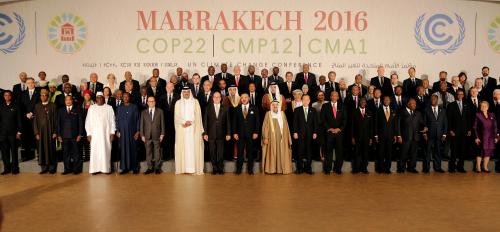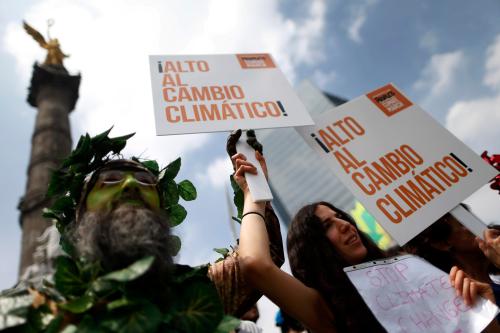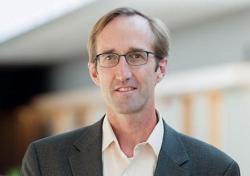After the dizzying heights of Paris last December, the United Nations climate change talks in the high desert of Marrakech, Morocco were always likely to be underwhelming. This, despite the culminating Action Proclamation calling for the “highest political commitment” to fighting climate change. The Moroccan government had a tough act to follow in the wake of a diplomatic masterclass by the French team to secure the adoption of the Paris Agreement.
With the agreement’s entry into force in record time four days before the U.S. presidential election, the Moroccan conference was geared toward implementation with a raft of pending decisions to be made on designing the various rules, guidelines, modalities, and procedures. The focus on putting flesh on the bones of the agreement was never likely to excite the same attention as adopting a grand, new deal.
Participants upon their arrival at the vast venue outside the ancient walls of the Marrakesh medina, or old city, were given a rustic burlap bag with four things inside: a reusable cup, a book on Marrakech, one explaining the venue, and a blank book with “Action Time” emblazoned on its cover.
Some of the worst outcomes of the Marrakech negotiations were that a few delicate issues were never resolved. The deadline for developing methods for measuring everything from emissions reductions to adaptation efforts to the delivery of climate finance is 2018. Some of the negotiation tracks working on these methods resulted in the planning of workshops and work programs to move their process forward, but others failed to settle on clear roadmaps to get them to clear and agreed rules in time for 2018. The fear is that nations will hold to their harder line positions too long, not allowing compromises needed to move forward. In this sense, the can is being kicked down the road.
But there is an important bright side that needs stressing about what’s transpired here in Marrakesh. The negotiations did manage to take care of a few technical things to keep the gears of the vast Paris Agreement moving forward. And more importantly, it provided a showcase for the announcement of a slew of initiatives from a broad range of groups. While a bit cacophonous, these many efforts together show that in fact global society is not going back to the pre-Paris world, regardless of the uncertainties following the U.S. presidential elections. That was a more important job for Marrakesh: to assure investors, business, and governments around the world that one rogue wave cannot swamp Paris.
Is implementation happening?
On the positive side, a number of new initiatives were launched or announced in Marrakesh, showing that we are moving forward. The implementation of the national climate plans (NDCs, in the U.N. jargon) received a boost: some interesting and ambitious long-term plans to decarbonize national economies were launched: and regional, national, and sectoral efforts received a boost. The Inter-American Development Bank unveiled a new platform to support Latin American and Caribbean countries transform their national climate pledges into achievable investment plans and mobilize resources for their implementation.
The U.S., Canada, and Mexico also announced long-term low-emission strategies known as “2050 plans.” The American and Canadian plans aim for 80 percent cuts based on 2005 levels by 2050 while Mexico aims to reduce emissions by 50 percent of 2000 emissions by mid-century. These are important efforts, though only two will have follow-through two months from now. A new multi-stakeholder initiative called the “2050 pathways platform” was launched that aims to support those seeking to devise long-term low emission and climate-resilient plans. More impressively, the group of 48 developing countries in the new Most Vulnerable Forum group pledge to go to 100 percent renewables by 2050. This from some of the world’s poorest countries, seeking to inspire the laggards around the world.
A range of public-private joint initiatives were announced or updates offered, such as the Marrakech Partnership for Global Climate Action, which aimed to show how nongovernmental actions will boost national actions; the Marrakech Investment Committee for Adaptation (MICA) Fund, a $500 million blended public/private finance fund; the Initiative for Renewable Island Energy, to help small-island developing states get off fossil fuels; an initiative on 26 African Capital Markets who signed the Marrakech Pledge for Fostering Green Capital Markets in Africa; and a European External Investment Plan (EEIP) to foster investment in Africa and the ”EU Neighborhood” to strengthen partnerships and to achieve the Sustainable Development Goals. This list could be ten times longer.
Action time?
Participants and observers watching a complex international institution come into existence needed to remember that this is something like watching a building being built. For weeks or months one sees nothing but a hole in the ground and some blocks of concrete. One wonders if anything is actually happening at all and if anything real will materialize. Then once the foundation is prepared and the materials and skilled labor gathered, the building seems to spring up all at once. This, we can hope, is what we will see over the next seven years as the Paris Agreement makes it through its first round of reviews in 2018, its official 2020 period of reporting, and the definitive “global stocktake” in 2023. Whether Marrakesh got enough done will only really become known in the coming years, but the general impression here is that some serious concrete is being poured.







Commentary
Disaster preparedness: A foundation for the Paris Climate Agreement that can withstand a Trump administration
November 18, 2016